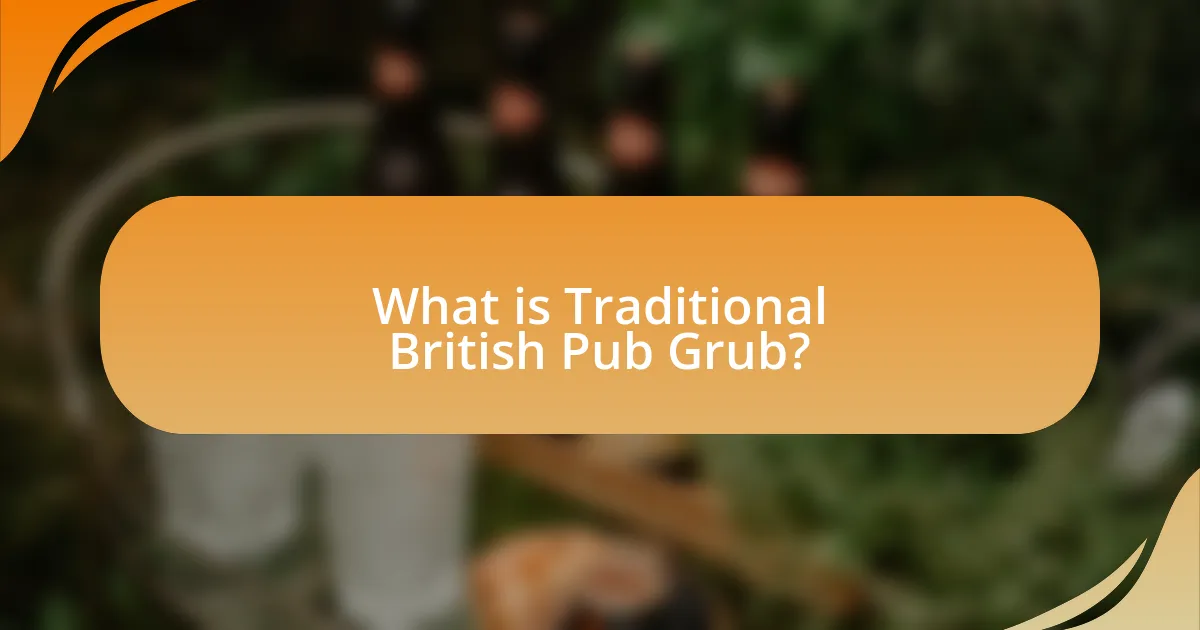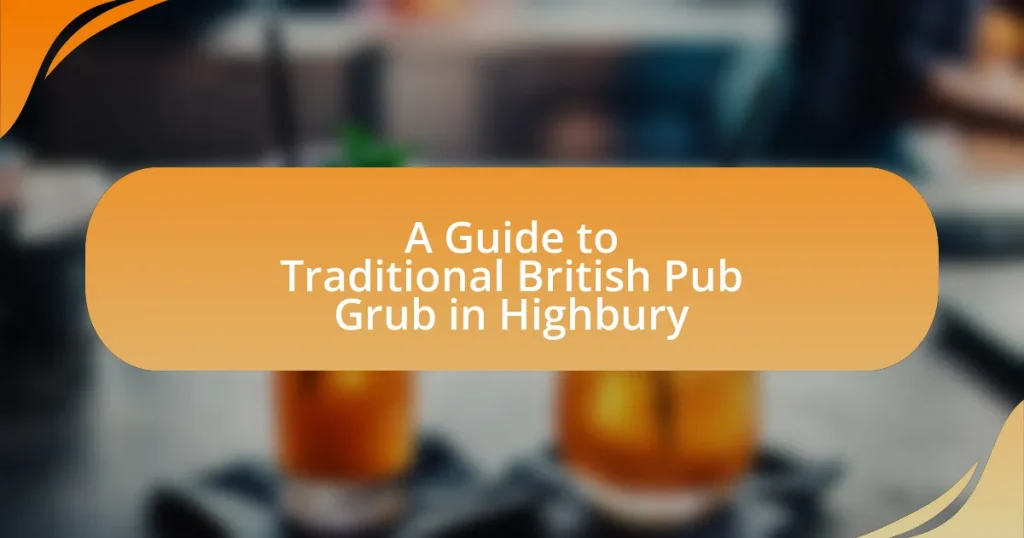Traditional British pub grub is a culinary staple in the United Kingdom, characterized by hearty dishes such as fish and chips, shepherd’s pie, and Sunday roasts, often made with locally sourced ingredients. This article explores the origins and historical influences of pub grub, tracing its evolution from simple meals for the working class to a more diverse and refined menu found in modern gastropubs. It highlights the significance of traditional dishes in British culture, the role of pubs as community hubs in Highbury, and the contemporary twists being added to classic recipes. Additionally, it provides insights into popular local dishes, tips for enjoying pub grub, and the best pubs in Highbury for an authentic dining experience.

What is Traditional British Pub Grub?
Traditional British pub grub refers to hearty, comforting food typically served in pubs across the United Kingdom. This cuisine often includes classic dishes such as fish and chips, shepherd’s pie, bangers and mash, and Sunday roasts, which are characterized by their use of locally sourced ingredients and traditional cooking methods. The historical significance of pub grub is rooted in the social culture of pubs as communal gathering places, where patrons enjoy substantial meals alongside drinks. This culinary tradition has evolved but remains a staple in British dining, reflecting regional variations and seasonal ingredients.
How did Traditional British Pub Grub originate?
Traditional British Pub Grub originated from the need to provide hearty, affordable meals for working-class patrons in pubs during the 19th century. As industrialization increased, pubs became central social hubs, serving simple, filling dishes like pies, stews, and fish and chips, which were easy to prepare and complemented the drinking culture. Historical records indicate that the introduction of the public house as a place for both drinking and dining solidified this culinary tradition, with many recipes passed down through generations, reflecting local ingredients and regional flavors.
What historical influences shaped Traditional British Pub Grub?
Traditional British Pub Grub has been shaped by various historical influences, including agricultural practices, social customs, and industrialization. The reliance on locally sourced ingredients, such as meats and vegetables, stems from the agrarian society of the Middle Ages, where pubs served as community hubs for farmers and laborers. Additionally, the Industrial Revolution in the 18th and 19th centuries led to the rise of working-class neighborhoods, where hearty, affordable meals became essential for laborers, resulting in dishes like pies and stews becoming staples. Furthermore, the influence of British colonialism introduced diverse flavors and ingredients, enriching traditional recipes. These historical contexts collectively define the essence of Traditional British Pub Grub.
How has Traditional British Pub Grub evolved over time?
Traditional British Pub Grub has evolved significantly from its origins in the 19th century, transitioning from simple, hearty meals designed for laborers to a more diverse and refined menu that reflects contemporary culinary trends. Initially, pub food consisted of basic dishes like pies, stews, and fish and chips, which catered to the working class and were often made with locally sourced ingredients. Over time, particularly in the late 20th century, the rise of gastropubs introduced a focus on quality and presentation, incorporating international flavors and gourmet techniques. This shift has led to the inclusion of dishes such as gourmet burgers, artisan pizzas, and vegetarian options, aligning with changing consumer preferences for healthier and more varied dining experiences. The evolution is evidenced by the increasing number of pubs offering seasonal menus and locally sourced produce, reflecting a broader trend towards sustainability and culinary innovation in British cuisine.
What are the key characteristics of Traditional British Pub Grub?
Traditional British Pub Grub is characterized by hearty, comforting dishes that often feature locally sourced ingredients. Common items include fish and chips, shepherd’s pie, and bangers and mash, which reflect the culinary traditions of the UK. These meals are typically simple, robust, and designed to be filling, catering to patrons looking for a satisfying dining experience. The emphasis on traditional recipes and preparation methods, such as slow cooking and frying, further solidifies the authenticity of this cuisine. Additionally, many pubs offer a selection of ales and beers that pair well with the food, enhancing the overall pub experience.
What ingredients are commonly used in Traditional British Pub Grub?
Traditional British Pub Grub commonly uses ingredients such as potatoes, meat (especially beef, lamb, and chicken), fish, and seasonal vegetables. These ingredients form the basis of classic dishes like fish and chips, shepherd’s pie, and bangers and mash. The reliance on locally sourced and seasonal produce reflects the culinary traditions of British pubs, which have historically emphasized hearty, comforting meals.
How does Traditional British Pub Grub reflect British culture?
Traditional British Pub Grub reflects British culture through its emphasis on hearty, comforting dishes that embody the values of community and tradition. The cuisine often features staples such as fish and chips, shepherd’s pie, and bangers and mash, which have historical roots in British agricultural practices and working-class life. These dishes not only provide sustenance but also foster social interaction, as pubs serve as communal gathering spaces where people share meals and stories. The use of locally sourced ingredients further highlights a connection to regional identity and culinary heritage, reinforcing the significance of place in British culture.
Why is Traditional British Pub Grub popular in Highbury?
Traditional British Pub Grub is popular in Highbury due to its cultural significance and community-oriented dining experience. The area’s rich history and vibrant local culture foster a strong appreciation for traditional dishes like fish and chips, shepherd’s pie, and Sunday roasts, which are staples in British cuisine. Additionally, Highbury’s pubs often serve as social hubs, where residents gather to enjoy hearty meals in a welcoming atmosphere, reinforcing the communal aspect of dining. The popularity is further supported by the presence of numerous pubs that emphasize locally sourced ingredients and traditional cooking methods, appealing to both locals and visitors seeking an authentic British culinary experience.
What role do pubs play in the community of Highbury?
Pubs in Highbury serve as vital social hubs that foster community engagement and interaction. They provide a space for residents to gather, socialize, and participate in local events, enhancing community cohesion. Pubs often host activities such as quiz nights, live music, and sports screenings, which contribute to a vibrant local culture. Additionally, they support local economies by sourcing food and beverages from nearby suppliers, thereby reinforcing community ties.
How does the atmosphere of Highbury pubs enhance the dining experience?
The atmosphere of Highbury pubs enhances the dining experience by creating a welcoming and vibrant environment that encourages social interaction. The combination of traditional decor, lively conversations, and the aroma of freshly prepared food fosters a sense of community among patrons. Studies show that a warm and inviting atmosphere can significantly improve customer satisfaction and increase the likelihood of repeat visits, as evidenced by the high ratings and positive reviews of local establishments. This unique ambiance, characterized by friendly staff and a relaxed setting, allows diners to enjoy their meals while engaging with friends and fellow patrons, ultimately enriching their overall experience.
What are the most popular dishes in Highbury’s Traditional British Pub Grub?
The most popular dishes in Highbury’s Traditional British Pub Grub include fish and chips, bangers and mash, shepherd’s pie, and Sunday roast. Fish and chips, a classic dish, features battered and fried fish served with chips, often accompanied by tartar sauce and mushy peas. Bangers and mash consists of sausages served with mashed potatoes and onion gravy, showcasing hearty British comfort food. Shepherd’s pie, made with minced lamb and topped with mashed potatoes, is another staple. The Sunday roast, typically featuring roasted meat, potatoes, and seasonal vegetables, is a traditional meal enjoyed by many in British pubs. These dishes reflect the rich culinary heritage of British pub cuisine.
What classic dishes should you try in Highbury?
In Highbury, you should try classic dishes such as fish and chips, shepherd’s pie, and bangers and mash. Fish and chips, a staple of British cuisine, features battered and fried fish served with thick-cut chips, often accompanied by tartar sauce and mushy peas. Shepherd’s pie, made with minced lamb and topped with creamy mashed potatoes, is a comforting dish that reflects traditional British home cooking. Bangers and mash consists of sausages served with mashed potatoes and onion gravy, showcasing the hearty flavors typical of British pub grub. These dishes are widely available in local pubs and restaurants, making them essential to experience the culinary heritage of the area.
What is the significance of Fish and Chips in British cuisine?
Fish and chips hold significant cultural and historical importance in British cuisine as a quintessential dish that symbolizes British culinary identity. Originating in the 19th century, fish and chips became popular among the working class, providing a cheap and filling meal. The dish gained further prominence during World War II when it was one of the few foods not rationed, reinforcing its status as a staple in British society. Today, fish and chips are celebrated not only for their taste but also as a representation of British heritage, often enjoyed in pubs and takeaway shops across the country.
How is the Full English Breakfast prepared and served in Highbury pubs?
The Full English Breakfast in Highbury pubs is typically prepared by cooking a combination of ingredients that includes eggs, bacon, sausages, baked beans, grilled tomatoes, mushrooms, and toast. Each component is cooked separately to ensure optimal flavor and texture, with eggs often fried or scrambled, and sausages and bacon grilled or fried until crispy.
Pubs serve this breakfast on a large plate, often accompanied by a side of black pudding, and it is common for establishments to offer variations based on local preferences. The meal is usually available throughout the morning and into early afternoon, catering to both locals and visitors seeking a hearty start to their day. Highbury pubs emphasize quality ingredients, often sourcing from local suppliers to enhance the authenticity of the dish.
What modern twists are being added to Traditional British Pub Grub in Highbury?
Modern twists being added to Traditional British Pub Grub in Highbury include the incorporation of global flavors, plant-based options, and gourmet presentations. For instance, classic dishes like fish and chips are being reimagined with sustainable seafood and innovative batters, while shepherd’s pie may feature alternative proteins such as lentils or jackfruit. Additionally, many pubs are enhancing their menus with artisanal ingredients and craft beverages, reflecting a trend towards quality and sustainability in dining. This evolution aligns with the growing consumer demand for diverse and health-conscious food choices in urban areas like Highbury.
How are local ingredients influencing pub menus in Highbury?
Local ingredients are significantly influencing pub menus in Highbury by enhancing the freshness and authenticity of the dishes offered. Many pubs in the area are sourcing produce, meats, and dairy from nearby farms, which not only supports local agriculture but also allows chefs to create seasonal menus that reflect the region’s culinary heritage. For instance, the use of locally sourced lamb and vegetables has become common, leading to dishes that are both flavorful and representative of Highbury’s local identity. This trend is supported by the increasing consumer demand for transparency in food sourcing, as patrons prefer meals that are not only delicious but also sustainable and community-oriented.
What innovative dishes are emerging in Highbury’s pub scene?
Innovative dishes emerging in Highbury’s pub scene include gourmet versions of classic British fare, such as truffle-infused fish and chips, and plant-based shepherd’s pie made with lentils and seasonal vegetables. These dishes reflect a trend towards elevating traditional pub grub by incorporating high-quality ingredients and modern culinary techniques. For instance, the use of truffle oil in fish and chips adds a luxurious twist, while the plant-based shepherd’s pie caters to the growing demand for vegetarian and vegan options, aligning with broader dietary trends observed in urban dining.

How can you enjoy Traditional British Pub Grub in Highbury?
To enjoy Traditional British Pub Grub in Highbury, visit local pubs known for their authentic offerings, such as fish and chips, bangers and mash, and shepherd’s pie. Establishments like The Highbury Barn and The Tufnell Park Tavern are popular choices, often praised for their quality and atmosphere. These venues typically source ingredients locally and prepare dishes in accordance with traditional recipes, ensuring an authentic dining experience.
What are the best pubs in Highbury for Traditional British Pub Grub?
The best pubs in Highbury for Traditional British Pub Grub include The Highbury Barn, The Tufnell Park Tavern, and The Old Dairy. The Highbury Barn is known for its classic fish and chips and hearty Sunday roasts, while The Tufnell Park Tavern offers a diverse menu featuring bangers and mash and shepherd’s pie. The Old Dairy is celebrated for its traditional pub atmosphere and serves favorites like steak and ale pie. These establishments consistently receive positive reviews for their authentic British cuisine and welcoming environments.
What unique features do these pubs offer to enhance your dining experience?
These pubs enhance the dining experience by offering unique features such as locally sourced ingredients, traditional recipes, and a cozy atmosphere. The use of locally sourced ingredients ensures freshness and supports local farmers, while traditional recipes provide an authentic taste of British cuisine. Additionally, the cozy atmosphere, often characterized by warm lighting and rustic decor, creates an inviting space for patrons to enjoy their meals. These elements collectively contribute to a memorable dining experience that reflects the cultural heritage of British pub grub.
How do the ambiance and decor of these pubs contribute to the overall experience?
The ambiance and decor of pubs significantly enhance the overall experience by creating a welcoming and immersive environment. A well-designed pub often features traditional elements such as wooden beams, cozy seating, and vintage decor, which evoke a sense of history and community. This atmosphere encourages social interaction and relaxation, making patrons feel at home. Studies indicate that environments with warm lighting and comfortable furnishings can increase customer satisfaction and dwell time, leading to higher spending. Therefore, the thoughtful integration of ambiance and decor not only enriches the dining experience but also fosters a connection between patrons and the cultural heritage of British pub traditions.
What tips should you consider when ordering Traditional British Pub Grub?
When ordering Traditional British Pub Grub, consider the pub’s specialties and seasonal offerings to enhance your dining experience. Many pubs take pride in their signature dishes, such as fish and chips or shepherd’s pie, which are often made with locally sourced ingredients. Additionally, inquire about daily specials, as these can provide a unique taste of traditional cuisine that may not be on the regular menu. Understanding portion sizes is also crucial; British pub meals are typically hearty, so sharing dishes or ordering smaller plates can be a practical choice. Lastly, pairing your meal with a traditional British ale or cider can complement the flavors of the food, enhancing the overall experience.
How can you pair drinks with your pub grub for the best experience?
To pair drinks with your pub grub for the best experience, match the flavors of the food with complementary beverages. For example, rich and hearty dishes like steak and ale pie pair well with a robust ale or stout, which enhances the savory flavors. Conversely, lighter fare such as fish and chips is best complemented by a crisp lager or a refreshing white wine, which balances the dish’s greasiness. Studies show that pairing food and drink based on flavor profiles can enhance the overall dining experience, as flavors interact and elevate each other.
What are some common etiquette tips for dining in a British pub?
Common etiquette tips for dining in a British pub include ordering at the bar, not at the table, and being prepared to pay upfront. Patrons should also wait for their food to be served at the bar or collect it when called, as table service is rare. Additionally, it is customary to tip around 10-15% if service is provided, although tipping is less formal than in restaurants. Respecting the pub’s atmosphere by keeping noise levels moderate and allowing space for other diners is also important. These practices reflect the traditional pub culture in Britain, where social interaction and community are emphasized.



